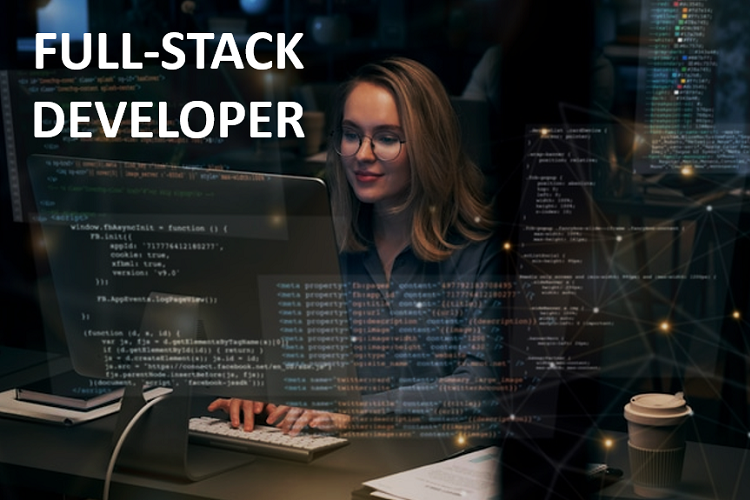In today’s rapid pace of digital disruption, having an exceptional website or mobile app is table stakes for any forward-thinking business. This fuels skyrocketing demand for a skilled full-stack developer who can deliver exceptional front-end user experiences powered by complex backend infrastructure.
But what exactly is a full-stack developer, what value do they bring to development teams, and how can you recruit these versatile unicorns? We’ll explore those key questions here.
What is a Full-Stack Developer?
First, let’s clearly define what a full-stack developer is.
A full-stack developer is a jack-of-all-trades who can work on both the front-end and back-end aspects of web or mobile app development. On the front-end, they build visually appealing and highly functional user interfaces with languages like HTML, CSS and JavaScript. On the back-end, they focus on server, database and infrastructure management using languages like Python, Node.js, PHP and .NET.
The key advantage is their versatility – a full-stack developer can potentially tackle an entire application build on their own. This distinguishes them from front-end only or back-end only developers who focus on one area of expertise.
As you evaluate your development needs, here are some key reasons why hiring a full-stack developer can be tremendously beneficial.
The Benefits of a Full-Stack Developer
Hiring a full stack developer carries multiple advantages over traditional specialist engineers:
-
Offer Versatility and Adaptability
The primary appeal of full-stack developers is how adaptable they can be in handling different aspects of application development. Beyond just front-end UI or back-end database work, they can pitch in on other key needs like:
- Version control with Git and GitHub
- Infrastructure management tasks
- Security and compliance checks
- Testing and QA
- Deployments and hosting
- Performance monitoring and optimization
This versatility is invaluable on small teams with limited headcount, as it streamlines workflow. A full-stack developer can handle tasks end-to-end instead of waiting on multiple specialists. Their understanding of the full app development life cycle also facilitates better collaboration cross-functionally.
-
More Efficient Utilization of Resources
Hiring a full-stack developer maximizes your development productivity per headcount resource. Since they can float between front-end, back-end and infrastructure tasks as needed, you reduce dependencies that could slow down delivery velocity.
It also assists communication, because a full-stack developer serves as a single point of contact across the entire architecture. Directions and specifications only need to be provided to them rather than relayed across multiple engineers.
-
Accelerate Development Cycles
Owning both front-end and back-end code allows full-stack developers to operate with autonomy in delivering application changes or new features end-to-end. They don’t sit blocked waiting for front-end markup, database tables or server changes from other team members.
This drives much faster iteration cycles and continuous deployment workflows. App changes can be pushed to production multiple times per week, keeping pace with agile sprints. Full testing automation assists too since full-stack resources build these scripts themselves leveraging expertise across the front and backend code.
Startups in hypergrowth mode greatly benefit from this velocity in responding quicker to customer feedback and user data.
-
Significant Cost Savings
Bringing on a full-stack developer filters away expenses from hiring both front-end and back-end focused engineers separately. In essence, you gain access to two skillsets – user interface design and server/infrastructure management – for the price of one well-rounded technical expert.
These savings add up over multi-year budget planning horizons. While full-stack developers demand higher base salaries – averaging $75,000 to $115,000 – you flatten sequential hiring curves by handling more internally. Those extra budget dollars can get invested into supplemental specialists like data engineers, DevOps architects and mobile developers as the product and team evolve.
There are hidden cost efficiencies too around lower HR overhead per hire and reducing project delays from cross-functional dependencies.
Clearly, full-stack skills provide versatility and velocity advantages. But navigating specialized recruitment carries challenges.
What are the Main Hiring Challenges with Full-Stack Roles?
Clearly, there are some great advantages to bringing a full-stack developer onto your web or mobile app development efforts. But it’s equally important to consider a few unique challenges that come with evaluating full-stack talent:
- It’s Hard to Find Candidates with Equal Mastery of Front-end and Back-end Skills
Full-stack developers are expected to wear many hats. So during the hiring process, it can be tricky assessing if a candidate is equally skilled in areas like UI development, database architecture and infrastructure management.
Often, they tend to lean heavier towards either front-end or back-end capabilities. Do your due diligence via technical assessments to uncover any glaring gaps for key roles they would fill.
- Keeping Their Skills Current Across a Wide Technology Spectrum is Challenging
Web and mobile technologies rapidly evolve each year, so full-stack developers must constantly be learning new languages and development techniques across front-end, back-end and infrastructure. This makes it exhausting for them to stay up-to-date across the broad set of capabilities they possess.
During interviews, discuss their learning plans and strategies to indicate they take skills development seriously. Once hired, make sure adequate time is allotted for continuing education alongside main project work.
- Cultural Fit Can Be Just as Important as Technical Skills
In addition to assessing hard technical skills, it’s critical that any full-stack developer hire also be evaluated for culture add. Factors like work style preferences, communication clarity and collaboration temperament carry heavy influence on long-term job satisfaction and tenure.
For example, some full-stack developers enjoy diving deep and delivering major backend infrastructure capabilities. Others prefer to stick to front-end application features. Make sure their motivations align with the role vision you have in mind before making a final decision.
What Should You Budget for a Full-Stack Developer?
When it comes to budgeting for a new full-stack hire, companies often wonder if the cost is justified compared to hiring specialized front-end and back-end developers separately. This concern is understandable.
On an individual basis, full-stack developers typically command higher base salaries – averaging between $75,274 and $114,182 per year according to PayScale. More experienced seniors can reach up to $136,000 annually.
These premiums reflect the broad range of expertise a quality full-stack candidate possesses across UI development, database architecture, infrastructure management and more. Specialized engineers generally make less since their capability scope is narrower.
However, viewed through a multi-year budget lens, full-stack developers can actually yield significant cost savings in the long run. You essentially “flatten the hiring curve” by leveraging a single resource versus having to bring on both front-end and back-end roles sequentially.
-
Conduct an Apples-to-Apples Cost Comparison
To determine true cost efficiency, conduct an apples-to-apples analysis on these two hiring approaches:
- Hiring one full-stack developer Year 1, with plans to add specialized front-end and back-end engineers Years 2 and 3.
- Hiring dedicated front-end and back-end developers Year 1.
Factor in projected headcount and salary assumptions for both scenarios over a 3-year timeline. This will illustrate total budget impact.
For example, your models may reveal:
- Full-Stack Approach: $115k Year 1, +$115k Year 2, +$150k Year 3 = $380,000 total
- Specialists Approach: $90k + $80k Year 1, +$90k + $80k Years 2 & 3 = $430,000 total
Despite a higher individual cost, the full-stack developer route saves $50,000 in budget over 3 years by avoiding multiple specialist hires upfront. These savings get reinvested in supplemental headcount as product needs evolve.
-
Account for Associated Recruiting Costs Too
Also incorporate HR overhead costs per new hire, which can range from $4,000 to $5,000 factoring in background checks, computers, office space and more. Specialized developer roles can double this expenditure if you hire front and backend separately. That’s an extra $8,000 to $10,000 to tally up.
Every additional recruiting cycle imposes time and productivity costs as well. Existing engineers spend cycles interviewing candidates or training new team members. With a full-stack hire, you limit these disruptions to just one onboarding effort.
-
Consider Long-Term Productivity Improvements
Lastly, analyze productivity upside. As highlighted earlier, full-stack developers streamline delivery velocities and application changes thanks to owning code end-to-end. This faster output benefits the business through quicker product iterations, increased customer satisfaction and the ability to support more initiatives simultaneously.
While complex to quantify, assign an estimated productivity value to these gains over 3 years. When combined with hard dollar savings, the full picture comes into focus – full stack skills provide scalability on a budget.
Factor in all direct costs, indirect overheads and productivity benefits into your analysis. This will determine the best engineering hiring path aligned to growth plans and budget realities.
What’s the Best Way to Hiring a Full-Stack Developer?
Finding and hiring suitable full-stack development candidates can prove challenging. Unlike more specialized front-end or back-end engineers, evaluation requires a rigorous assessment across a wider skillset.
You want to both validate technical expertise across multiple domains like programming languages, frameworks and infrastructure while also screening for adaptable team players.
Follow these tips to improve your full-stack recruiting strategy:
-
Define Must-Have and Nice-to-Have Technical Skills
Create a clear blueprint of the essential frontend, backend and infrastructure capabilities you require. For example:
Must-Have:
- Frontend: HTML5, CSS3, JavaScript (ES6)
- Backend: Node.js, Python
- Infrastructure: AWS, Docker, Git
Nice-to-Have:
- Frontend Frameworks: React and Angular
- Backend Frameworks: Express and Django
- Infrastructure Tools: Kafka, Spark and MySQL
This allows precise filtering for candidates meeting your core technical needs from those with supplementary skills. Prioritize must-haves first before factoring in nice-to-have experience during selection.
-
Develop a Compelling Yet Honest Full-Stack Job Description
The job description is your hook to capture interest from passive candidates open to new roles. Convey actual responsibilities and types of full-stack projects they would work on. Highlight opportunities to gain broad exposure across application layers.
But also be transparent about must-have qualifications so expectations are calibrated. Disclosing your technical stack upfront allows developers to self-select out if their skills don’t align. No point wasting each other’s time interviewing.
-
Cast a Wide Net Across Diverse Platforms and Communities
Employ both broad-based and niche web development job boards to source candidates:
- Mainstream – Indeed, Monster, Dice
- Specialized – WeWorkRemotely, ReactJS Jobs
- Communities – LinkedIn, Reddit, Slack/Discord Groups
Customize postings across platforms to resonate with each audience. Participate in groups to directly engage talented individuals open to something new.
-
Assess Both Technical Chops and Culture Fit
A standardized coding test or technical screen should kick off the process to validate must-have requirements. Schedule remote pair programming sessions for candidates to tackle problems together.
This demonstrates firsthand skills while also assessing teamwork tendencies. On-site interviews take this further with whiteboard exercises modeling real issues.
Finally, have candidates meet with staff outside of engineering to evaluate collaboration temperament. Check references to verify past team integration.
-
Close Candidates with Strong Learning and Growth Opportunities
Even seasoned full-stack developers need continual skills development in such a dynamic field. Emphasize training programs, conference participation, certification reimbursement and more within compensation.
This shows your commitment to leveling up their expertise over time. It’s a key retention driver for rockstar talent with no shortage of job options.
-
Bring the Right Full-Stack Developer Onboard
Hiring full-stack engineers saves time and money over assembling specialized front-end, back-end and DevOps teams. But poor choices result in mismatched skills or cultural friction that paralyze projects.
Thoughtfully assessing both technical ability and collaboration behaviors is the formula for successfully onboarding full-stack talent. They will serve as a scalable backbone enabling your engineering team to take on more initiatives simultaneously.
Wrapping Up
Adding a talented full-stack developer to your team can work wonders in accelerating digital product development. Their versatility and adaptability allows for efficient task-switching and tighter collaboration. When supported with robust learning resources, they evolve into versatile technical leaders over time.
Carefully assess both technical expertise and culture fit during hiring to find the right match. While full-stack developers demand higher salaries, they provide tremendous value by reducing dependencies on multiple specialists.
If you hire fullstack developers matching key technical skills and culture fit criteria early on, they will serve as force multipliers for product innovation and change management. Prioritize their continuous education and project enrichment so they grow in tandem with your team’s expanding needs.
Pratik is a creative content writer at ThinkODC with a passion for all things digital. He has developed a wide range of content for clients in diverse fields such as technology, fashion, beauty, and health. His writing style is engaging, informative, and conversational, making his content relatable to all types of readers.




